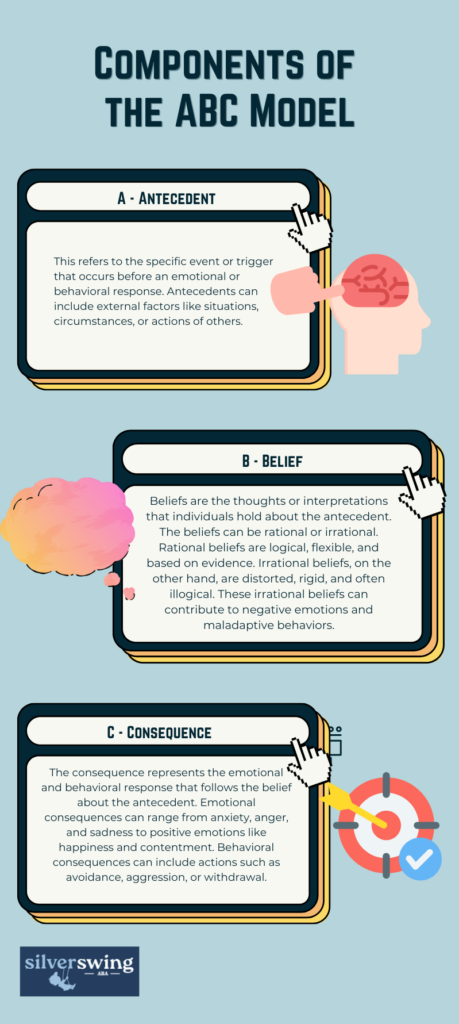The ABC Model is a fundamental concept in behavior therapy, particularly in Cognitive Behavioral Therapy (CBT). Developed by psychologist Albert Ellis, the ABC Model is a key component of Rational-Emotive Behavior Therapy (REBT) and serves as a framework for understanding the relationship between beliefs, emotions, and behaviors.
Overview of the ABC Model
The ABC Model states that external events (A) do not directly cause emotions (C), but it is the beliefs (B), particularly irrational beliefs, that influence our emotional and behavioral responses. This model highlights the significance of our thoughts and interpretations in shaping our emotional experiences and subsequent actions.
By examining the ABC Model, individuals can gain a better understanding of their reactions to specific situations and work towards more constructive responses. It provides a framework for identifying and challenging irrational beliefs, which can lead to more rational and adaptive thinking patterns.
Components of the ABC Model
The ABC Model consists of three main components:

Understanding the ABC Model allows individuals to recognize the connections between their beliefs, emotions, and behaviors. By identifying and challenging irrational beliefs, individuals can restructure their thinking patterns to promote more positive and adaptive emotional and behavioral outcomes.
The ABC Model is a powerful tool used in therapy to help individuals gain insight into their thoughts and emotions, develop healthier beliefs, and ultimately transform their behavior.

Application of the ABC Model
The ABC Model is a powerful tool that can be applied in various therapeutic settings to transform behavior. Let’s explore how the ABC Model can be used in therapy and how it can be modified for different situations.
Using the ABC Model in Therapy
The ABC Model is widely used in therapy, particularly in Cognitive Behavioral Therapy (CBT). Therapists employ this model to help individuals identify the connection between their thoughts, emotions, and behaviors. By understanding the sequence of events in a given situation, individuals can gain insight into the factors that contribute to their reactions.
In therapy, the therapist guides the individual through the ABC process. They help identify the Antecedent, which is the event or trigger that precedes the behavior. Then, they explore the Beliefs or thoughts that the individual holds about the situation. Finally, they examine the Consequences, which are the emotional and behavioral reactions that follow.
By analyzing the ABC sequence, individuals can gain a deeper understanding of their automatic thoughts and beliefs that may be contributing to their emotional and behavioral responses. This awareness allows them to challenge irrational beliefs and develop more practical and rational ways of handling stressful situations.

Modifying the ABC Model for Different Situations
The versatility of the ABC Model allows for its modification to suit different situations and therapeutic needs. For example, in situations involving grief, the ABC Model can be adapted by substituting logical disputation with legitimizing and normalizing beliefs. This modification acknowledges the unique challenges and emotions associated with grief and provides a compassionate framework for understanding and processing these feelings.
Furthermore, the ABC Model can be extended to an ABCDE model, with “D” representing the disputation of beliefs and “E” representing a “new effect.” This extension helps individuals challenge irrational beliefs and replace them with more rational thoughts, leading to a positive outcome. By questioning the accuracy and validity of their beliefs, individuals can reframe their thinking and adopt a more constructive perspective.
The ability to modify the ABC Model for different situations makes it a valuable tool in therapy. Therapists can tailor the approach to address specific cognitive distortions and irrational beliefs, guiding individuals toward more rational thoughts and positive emotions. This adaptability is especially evident in Cognitive Behavioral Therapy (CBT), where therapists combine the ABC Model with other CBT frameworks to support individuals in developing practical and rational ways to handle stressful situations.
Effectiveness of the ABC Model
The ABC Model of behavior therapy has proven to be highly effective in transforming behavior and improving mental health outcomes. By understanding the impact of antecedents, behaviors, and consequences, individuals can gain insight into the underlying factors that contribute to their thoughts, emotions, and actions. Let’s explore the effectiveness of the ABC Model in reducing symptoms and its impact on mental health conditions.
Reducing Symptoms with the ABC Model
The ABC Model has shown promising results in reducing symptoms related to various mental health conditions. By identifying and addressing dysfunctional thinking patterns, individuals can gain control over their emotional and behavioral responses. The ABC Model assists in recognizing automatic thoughts and exploring alternative solutions to problems, leading to more rational thoughts and positive emotions.
In studies, the ABC Model has been particularly effective in reducing symptoms of depression and anxiety. It helps individuals recognize irrational thoughts and beliefs, fostering rational thinking to respond to situations in a healthier manner. By challenging negative beliefs and developing more practical and rational ways to handle stressful scenarios, individuals can experience a reduction in symptoms and an improvement in overall well-being.
Impact on Mental Health Conditions
The application of the ABC Model extends beyond symptom reduction; it has proven to be beneficial in treating various mental health conditions. The model is widely utilized in Cognitive Behavioral Therapy (CBT) to address cognitive distortions and irrational beliefs that contribute to the development and maintenance of mental health disorders.
Conditions such as depression, anxiety, addiction, and eating disorders can be effectively treated with the ABC Model. By guiding individuals to identify inaccurate beliefs about situations, the model facilitates the assessment of the truth behind these beliefs, leading to improved reactions and adaptive coping strategies. Therapists using CBT often combine the ABC Model with other frameworks and assign homework to help individuals apply what they’ve learned in real-life situations, guiding them to approach daily stressors more positively.
The ABC Model, with its emphasis on understanding the relationship between thoughts, emotions, and behaviors, provides individuals with the tools to challenge negative beliefs, develop more practical thinking patterns, and cultivate healthier responses. This transformative approach enables individuals to gain a deeper understanding of their own cognitive processes and empowers them to make positive changes in their lives.
By implementing the ABC Model and working closely with a qualified professional, individuals can experience significant improvements in their mental health and overall well-being.

ABC Model in ABA Therapy
The ABC model is also central to ABA therapy. This model provides a structured framework for understanding and modifying behavior, allowing therapists to develop precise and effective interventions. By analyzing the triggers and outcomes of behaviors, the ABC model helps in identifying the underlying causes of behavioral issues and creating strategies to promote positive changes.
1. Behavioral Assessment
ABA therapists conduct a Functional Behavior Assessment (FBA) to identify the antecedents and consequences that maintain problematic behaviors. This assessment helps in understanding the purpose or function of the behavior (e.g., seeking attention, escaping a task).
2. Intervention Planning
Based on the findings from the FBA, ABA therapists develop individualized intervention plans that address the identified antecedents and consequences. For instance, if a behavior is maintained by gaining attention, an intervention might include teaching alternative, appropriate ways to seek attention.
3. Implementing Interventions
- Modifying Antecedents: Therapists might change the environment or conditions leading up to the behavior. For example, if a child engages in disruptive behavior when tasks are too difficult, the antecedent modification could include adjusting the task difficulty or providing clearer instructions.
- Reinforcing Desired Behaviors: Therapists provide positive reinforcement for desirable behaviors, such as verbal praise, tokens, or other rewards, immediately following the behavior to increase its occurrence.
- Reducing Reinforcement for Undesirable Behaviors: To decrease undesirable behaviors, therapists might use strategies such as ignoring the behavior (if it is attention-seeking) or implementing a consequence that is less rewarding.
4. Data Collection and Analysis:
ABA therapy relies heavily on continuous data collection to monitor the frequency, duration, and intensity of behaviors. By analyzing this data, therapists can determine the effectiveness of interventions and make necessary adjustments.
5. Training and Support
ABA therapists train caregivers, teachers, and other individuals in the child’s environment to consistently apply the ABC model strategies. This ensures that behavior modification techniques are implemented across different settings, promoting generalization and maintenance of positive behaviors.
Overall, the ABC model provides a clear framework for understanding and changing behavior. By systematically analyzing and modifying antecedents and consequences, ABA therapists can develop effective, individualized interventions that promote positive behavior change and skill development.




